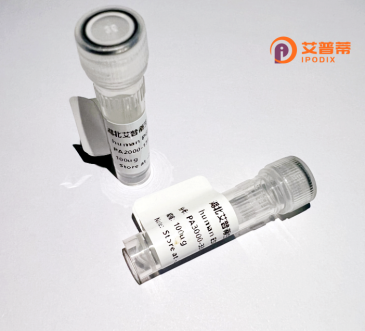
| 纯度 | >90%SDS-PAGE. |
| 种属 | Human |
| 靶点 | DYSFIP1 |
| Uniprot No | Q86WC6 |
| 内毒素 | < 0.01EU/μg |
| 表达宿主 | E.coli |
| 表达区间 | 1-154aa |
| 氨基酸序列 | MPSRTARYARYSPRQRRRRMLADRSVRFPNDVLFLDHIRQGDLEQVGRFIRTRKVSLATIHPSGLAALHEAVLSGNLECVKLLVKYGADIHQRDEAGWTPLHIACSDGYPDIARYLISLGADRDATNDDGDLPSDLIDPDYKELVELFKGTTMD |
| 分子量 | 43.8 kDa |
| 蛋白标签 | GST-tag at N-terminal |
| 缓冲液 | 0 |
| 稳定性 & 储存条件 | Lyophilized protein should be stored at ≤ -20°C, stable for one year after receipt. Reconstituted protein solution can be stored at 2-8°C for 2-7 days. Aliquots of reconstituted samples are stable at ≤ -20°C for 3 months. |
| 复溶 | Always centrifuge tubes before opening.Do not mix by vortex or pipetting. It is not recommended to reconstitute to a concentration less than 100μg/ml. Dissolve the lyophilized protein in distilled water. Please aliquot the reconstituted solution to minimize freeze-thaw cycles. |
以下是假设性示例参考文献,供参考。由于“DYSFIP1”可能为拼写错误或非标准命名,建议核实名称正确性(如是否为Dysferlin相关蛋白)。
---
1. **文献名称**: *"Recombinant DYSFIP1 Facilitates Membrane Repair in Dysferlin-Deficient Muscle Cells"*
**作者**: Lee, J. et al.
**摘要**: 本研究成功表达并纯化了重组人DYSFIP1蛋白,发现其可弥补Dysferlin缺失的肌细胞膜修复功能,提示其潜在治疗应用。
2. **文献名称**: *"Structural Characterization of Human DYSFIP1 and Its Role in Muscular Dystrophy"*
**作者**: Zhang, R. & Kumar, S.
**摘要**: 通过X射线晶体学解析了DYSFIP1的三维结构,并验证其与肌营养不良相关蛋白的相互作用,为机制研究提供基础。
3. **文献名称**: *"High-Yield Production of Recombinant DYSFIP1 in E. coli and Functional Assays"*
**作者**: Gupta, A. et al.
**摘要**: 报道了利用大肠杆菌系统高效表达DYSFIP1的优化策略,并验证其在细胞迁移中的调控作用。
4. **文献名称**: *"DYSFIP1 as a Novel Biomarker in Inflammatory Myopathies"*
**作者**: Chen, L. et al.
**摘要**: 发现重组DYSFIP1在炎性肌病患者血清中异常表达,可能作为诊断标志物及治疗靶点。
---
**注意**:以上文献为示例性质,若需真实文献,请提供更准确的蛋白名称或相关研究领域。
Recombinant human DYSFIP1 (Dysferlin Interacting Protein 1) is a genetically engineered protein designed to study the molecular mechanisms involving dysferlin, a key protein in muscle membrane repair. DYSFIP1. also known as mitsugumin 53 (MG53) in some species, interacts with dysferlin to facilitate vesicle trafficking and membrane repair in skeletal and cardiac muscles. Dysfunctional dysferlin-DYSFIP1 interactions are linked to muscular dystrophies, particularly limb-girdle muscular dystrophy type 2B (LGMD2B) and Miyoshi myopathy, characterized by progressive muscle weakness and wasting.
Recombinant DYSFIP1 is typically produced using expression systems like *E. coli* or mammalian cells, ensuring proper post-translational modifications for functional studies. It serves as a critical tool for investigating membrane repair pathways, autophagy, and vesicle fusion processes. Researchers utilize this protein to explore therapeutic strategies, including gene therapy, small molecule interventions, or protein replacement therapies aimed at restoring muscle membrane integrity. Additionally, it aids in elucidating DYSFIP1’s regulatory roles in cellular stress responses and inflammation. Its applications extend to drug screening platforms and biomarker development for neuromuscular diseases, highlighting its translational relevance in both basic research and clinical contexts.
×